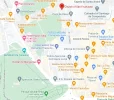WanderingBrian
Active Member
- Time of past OR future Camino
- Sept 2023
| Remove ads on the forum by becoming a donating member. More here. |
|---|
You are right! ThanksI'm guessing Alameda Park. The view from there over the old city is postcard-worthy.

 vivecamino.com
vivecamino.com

No, it's not (unless you walk in by a very indirect route). If you follow the yellow arrows you don't pass a park on the way to the Praza do Obradoiro. Oh! There is a bit of green and a few trees and tennis courts around Praza de Sofía. There is quite a bit of greenery around the University area, but you wouldn't go near there if you were following the yellow arrows. You would pass by the Alameda if you were walking the Camino Portugués.Is Alameda Park the one that you pass when you walk into Santiago from Monte de Gozo. It is by the University correct?
Maybe I should not be lazy and look at google maps hahaNo, it's not (unless you walk in by a very indirect route). If you follow the yellow arrows you don't pass a park on the way to the Praza do Obradoiro. Oh! There is a bit of green and a few trees and tennis courts around Praza de Sofía. There is quite a bit of greenery around the University area, but you wouldn't go near there if you were following the yellow arrows.
I am pretty sure this picture was taken inLong before I knew anything about the Camino, I visited Santiago with my wife as part of a multi-week Spain trip. She snapped this photo of me. Does anyone know where this was taken in Santiago? I figure it's probably easily identifiable by someone.
Also known as part of the Alameda Park (see posts 2 and 3).I am pretty sure this picture was taken in
Carballeira De Santa Susana park.
Correct - this is a magnificent Blue Gum specimen (Eucalyptus globulus) - see https://en.wikipedia.org/wiki/Eucalyptus_globulus.Gum = eucaliptus ? I didn't know.
Now the Xunta is limiting the gum plantations in Galicia.
Since 10 years ago, in Galicia 90% of the eucalytus plantations are nitens that have more productivity and plague resistance than globulus.Correct - this is a magnificent Blue Gum specimen (Eucalyptus globulus) - see https://en.wikipedia.org/wiki/Eucalyptus_globulus.
Blue Gums were planted extensively across northern Spain and adjoining areas of Portugal some 30 or 40 years ago, presumably for their hardwood timber value (saw logs, chip wood or poles). Blue gums are fast growing, and produce long straight-grained sawlogs suitable for flooring, framing timber and furniture.
What was probably not appreciated at the time was the increased fire risk that eucalypt plantations bring - a consequence ot the increased timber production, the fallen bark and leaves providing fuel at the ground, and the highly flammable eucalyptus oil in the leaves. We in Australia are accustomed to the risk and manage it with varying degrees of success. I recall severe forest fires in northen pain and Portugal in 2017 and 2018 (and no doubt many years) with some deaths.
As with any 'foreign' monoculture, this comes at a cost to the local environment, and it is up to the sociery of the day (and their government) to make choices on environmental and heritage protection, public safety, and jobs and economic activity.
Thank you -- I stand corrected.Since 10 years ago, in Galicia 90% of the eucalytus plantations are nitens that have more productivity and plague resistance than globulus.
I think that almost everthing goes for paper pulp and the company ENCE is the only final buyer.
The Xunta laws to reduce eucalytus plantations in Galicia are necessary, in my opinion , for its negative enviroment impact but the consequence is that many fields now are worth less than a half than before.


